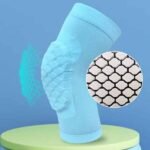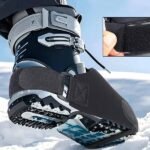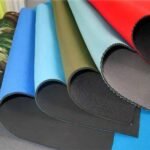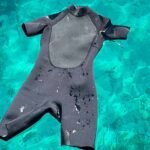Walk through any surf shop, gym, or tech-bag display, and you’ll spot neoprene — that smooth, slightly spongy fabric that feels both futuristic and functional. It’s in wetsuits, laptop sleeves, bottle koozies, and even high-fashion tote bags. But there’s one question buyers always ask: “Is neoprene hot to wear?”
The answer depends on how you use it, where you wear it, and how it’s designed. Neoprene’s closed-cell foam structure makes it an excellent thermal insulator — keeping you warm in cold water or winter air. Yet the same property can make it feel less breathable in tropical climates or during long wear indoors.
Neoprene fabric retains heat because its closed-cell structure traps air and blocks moisture, making it naturally insulating. It keeps you warm in cold or wet conditions — ideal for wetsuits, gloves, or thermal bags. However, in hot weather or prolonged wear, neoprene can feel warm due to limited airflow. Comfort depends on thickness, lining, and ventilation design.
That’s why neoprene’s reputation swings between “hot and sweaty” and “cozy and protective.” The truth lies somewhere in between — and understanding it helps both buyers and designers choose the right neoprene for the right use.
So let’s break it down: what neoprene really is, why it feels warm, and how manufacturers engineer around that balance of comfort and insulation.
What Is Neoprene Fabric?

Neoprene is a synthetic rubber foam known for its elasticity, water resistance, and thermal insulation. It’s made by polymerizing chloroprene into flexible sheets filled with tiny air cells. These cells trap heat and cushion impact, making neoprene ideal for wetsuits, laptop sleeves, gloves, covers, and insulated bags.
Neoprene is technically called polychloroprene, first developed by DuPont in the 1930s as an oil-resistant rubber. Its closed-cell foam structure — millions of microscopic nitrogen bubbles sealed inside — makes it unique among fabrics. This structure gives neoprene three key properties:
- Thermal insulation: The trapped gas pockets reduce heat transfer, keeping warmth inside.
- Water resistance: Water can’t penetrate the closed cells, making it semi-impermeable.
- Elasticity: It stretches in all directions and rebounds to shape, offering a soft yet durable feel.
Today, neoprene is used across multiple industries — from scuba diving to fashion and tech accessories. Its density, texture, and stretch vary by formulation:
- Limestone neoprene: more eco-friendly and lightweight.
- Petro-based neoprene: classic version used in wetsuits.
- Composite neoprene: bonded with fabrics like polyester or nylon for added comfort.
Comparing Neoprene with Other Common Fabrics
| Material | Structure | Thermal Retention | Water Resistance | Breathability | Typical Use |
|---|---|---|---|---|---|
| Neoprene | Closed-cell foam | ★★★★★ Excellent | ★★★★★ Excellent | ★☆☆☆☆ Low | Wetsuits, gloves, bags |
| Polyester | Woven synthetic | ★★★ Moderate | ★★★ Moderate | ★★★ Moderate | Sportswear, outerwear |
| Cotton | Natural fiber | ★★ Low | ★ Low | ★★★★★ High | T-shirts, casual wear |
| Nylon | Tight synthetic weave | ★★★ Moderate | ★★★★ Good | ★★★ Moderate | Windbreakers, covers |
| Spandex/Lycra | Elastic knit | ★★ Low | ★ Low | ★★★★ High | Activewear, stretch gear |
In short: neoprene retains heat far better than cotton or nylon but breathes far less. It’s not “hot” by defect — it’s just designed to preserve warmth, not release it.
Why That Matters for Buyers and Designers
If you’re wearing neoprene as clothing, the question isn’t whether it’s hot — it’s whether that warmth is desirable.
- In cold or windy settings, it’s protective and comfortable.
- In humid, tropical areas, it can feel heavy unless ventilated or laminated with breathable linings.
The best products use hybrid constructions — combining neoprene’s insulation with fabrics that manage moisture and air flow. That’s why some laptop sleeves or backpacks feel soft and dry, while others feel sticky or clammy after long use: it all depends on the inner and outer lamination layers.
Is Neoprene Hot to Wear?
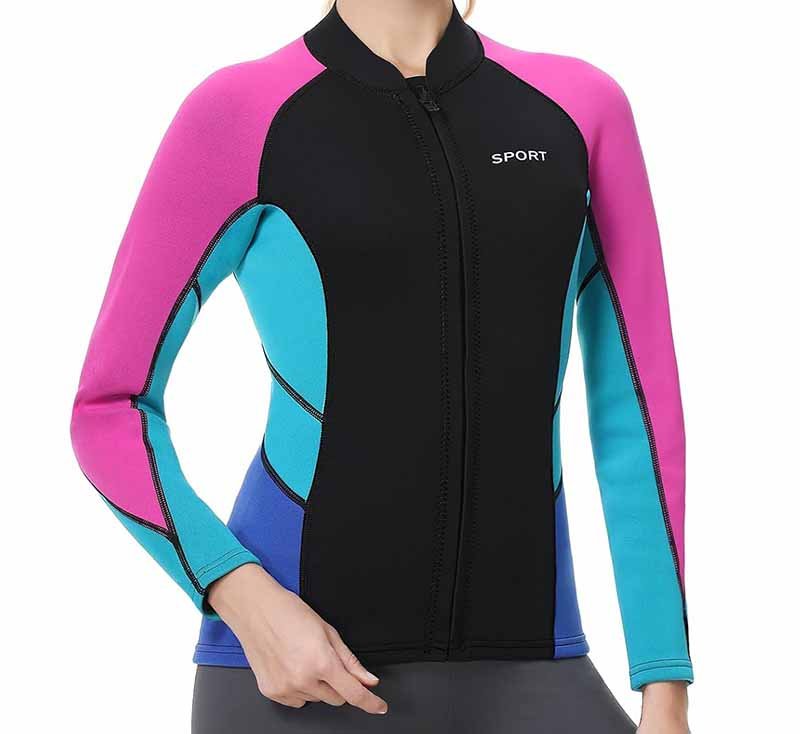
Yes, neoprene can feel hot because it traps body heat and limits airflow. Its insulating foam keeps warmth close to the skin, making it excellent for cold weather or underwater use but less ideal for summer or high-intensity activity. Comfort depends on thickness, ventilation, and the type of fabric lining used.
When neoprene touches the skin, it immediately starts trapping heat. That’s great if you’re surfing in 60°F water — not so great if you’re carrying a neoprene backpack in 95°F sun.
Neoprene’s insulation works both ways: it keeps external cold out and internal warmth in. The foam layer doesn’t let air circulate, which means sweat and heat can accumulate faster than they dissipate.
But not all neoprene behaves the same. Temperature comfort depends on four main factors:
- Thickness (mm):
- 1–2 mm = Light insulation (comfortable in mild weather).
- 3–4 mm = Medium warmth (standard wetsuits).
- 5+ mm = Heavy insulation (cold-water gear).
- Cell Density: Denser neoprene (fewer, smaller air pockets) traps heat more effectively but also feels less flexible.
- Fabric Lining: Neoprene is rarely used bare; it’s laminated with nylon, polyester, or jersey knit. These linings wick moisture and improve comfort — the difference between “sweaty rubber” and “smooth, wearable fabric.”
- Ventilation Design: Perforated panels, mesh zones, or thinner side walls can dramatically improve airflow without sacrificing structure.
Heat Retention Comparison by Thickness
| Neoprene Thickness (mm) | Typical Use | Heat Retention | Comfort Rating (1–5) |
|---|---|---|---|
| 1 mm | Light bags, fashion wear | ★★ Moderate | ★★★★ Comfortable |
| 2–3 mm | Laptop sleeves, gloves, sport braces | ★★★ Good | ★★★ Balanced |
| 4–5 mm | Wetsuits, bottle covers | ★★★★ High | ★★ Warm |
| 6 mm+ | Diving gear, cold protection | ★★★★★ Very High | ★ Hot |
As you can see, warmth rises quickly with thickness. A 3 mm neoprene yoga mat cover or camera case stays pleasant to the touch, while a 5 mm wetsuit becomes sauna-like on land.
When Does Neoprene Keep You Comfortable?
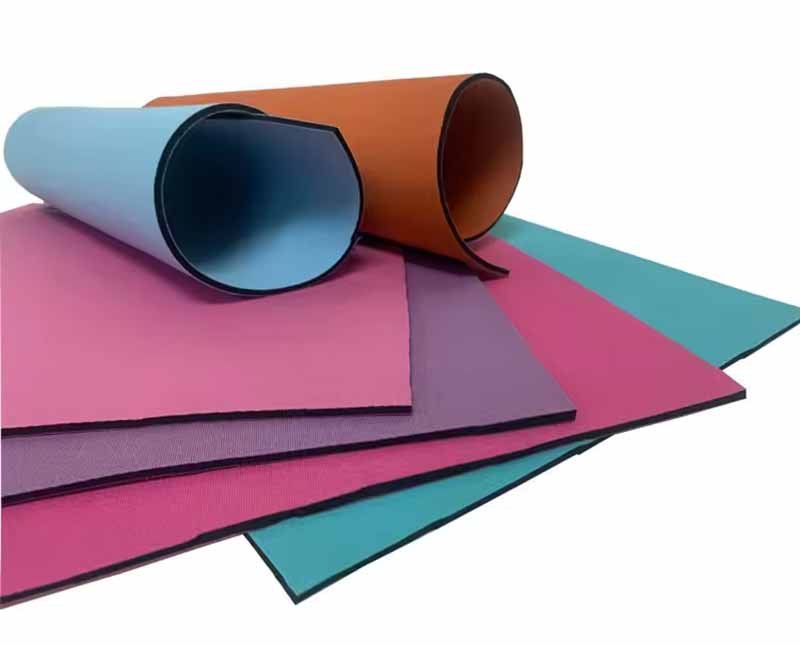
Neoprene keeps you comfortable when external conditions are cool or when warmth and protection outweigh breathability—like surfing, diving, or carrying temperature-sensitive items. It’s most effective in wind, rain, or water exposure, where its insulation and cushioning outperform fabric alternatives. In moderate climates, thin neoprene (1–2 mm) or ventilated designs maintain comfort without overheating.
Neoprene’s comfort depends less on the material itself and more on how—and where—it’s used.
Think of it as a “thermal manager” rather than a “hot fabric.” When engineered correctly, neoprene can feel smooth, flexible, and body-responsive.
1. Cold and Windy Environments
In cool or windy conditions, neoprene performs like a personal barrier.
The air pockets inside the rubber foam trap body heat, maintaining a steady micro-temperature layer between skin and fabric.
That’s why 2–3 mm neoprene gloves, sleeves, and wetsuits remain the go-to material for cold-water sports or alpine workouts.
Even outside of sports, neoprene is used in everyday items precisely for its comfort under temperature swings—from laptop sleeves that protect electronics from condensation to cooler bags that preserve temperature consistency during commutes.
2. Daily Accessories and Moderate Activity
For non-wearable items such as backpacks, lunch totes, and bottle covers, neoprene’s “warmth” becomes a protective feature rather than discomfort.
It prevents condensation in drink coolers and keeps hand-carried devices at stable temperatures.
In fashion and consumer goods, the soft-touch comfort, spongy elasticity, and sleek finish make it feel premium—not “hot.”
3. The Right Thickness for Everyday Comfort
Neoprene’s thermal behavior scales directly with thickness.
Here’s how typical product categories align with comfort levels:
| Product Type | Thickness (mm) | Warmth Level | Comfort Rating (1–5) | Typical Environment |
|---|---|---|---|---|
| Laptop Sleeve | 2 mm | Moderate | ★★★★★ | Indoor / Office |
| Fashion Tote | 3 mm | Medium | ★★★★ | Temperate Climate |
| Fitness Waist Belt | 4 mm | High | ★★★ | Gym / Outdoor |
| Wetsuit | 5 mm | Very High | ★★ | Cold Water |
| Thermal Cover | 6 mm+ | Extreme | ★ | Freezing Weather |
Pro Tip: Comfort peaks between 2 mm and 3 mm thickness—where flexibility and warmth balance perfectly for most users and climates.
4. Moisture and Mobility Factor
Neoprene stays flexible even when wet.
Unlike cotton or polyester that absorb moisture, it resists water, allowing steady comfort in splash-prone or humid conditions.
That’s why divers and swimmers never complain about “cold shock” once in water—the suit equalizes quickly and maintains core warmth.
5. Comfort Isn’t Only Temperature
Modern consumers also interpret comfort as feel, weight, and freedom of movement.
Neoprene’s cushioned handfeel and body-adaptive stretch create a sense of quality—why it’s increasingly popular in luxury handbags, footwear, and tech gear.
When engineered with the right lining and perforation, it feels more ergonomic than hot.
How to Make Neoprene More Breathable
Designers improve neoprene’s breathability by reducing thickness, adding perforations, laminating with breathable fabrics, or blending it with mesh or nylon. These methods allow trapped air and heat to escape without compromising protection. Modern innovations like laser-cut vents, 3D-knit linings, and lightweight neoprene foams keep products cooler while maintaining durability and flexibility.
If traditional neoprene feels like a thermal shield, modern neoprene design is all about control—keeping its protective power while letting heat escape.
Here’s how brands and manufacturers achieve that balance:
1. Perforated Neoprene
Tiny, evenly spaced holes allow micro-ventilation.
Perforated neoprene is commonly used in sport braces, car seat covers, and yoga accessories.
The holes don’t fully penetrate the material’s waterproof layer but create enough airflow to prevent moisture buildup.
| Design Type | Airflow Efficiency | Water Resistance | Comfort Use Case |
|---|---|---|---|
| Solid Sheet | ★ | ★★★★★ | Thermal bags, diving gear |
| Micro-Perforated | ★★★★ | ★★★ | Sportswear, braces |
| Large Perforated | ★★★★★ | ★★ | Car seats, gym mats |
Note: Micro-perforation increases breathability by up to 50 % without losing structure integrity.
2. Fabric Lamination and Hybrid Construction
Neoprene is often bonded with fabrics like nylon, polyester, or jersey knit.
These outer layers wick away moisture, protect the foam from friction, and add softness.
For high-end applications, some factories use double-laminated neoprene: nylon on one side and mesh or cotton on the other for better skin contact and airflow.
Laminations aren’t just decorative—they redefine how “hot” neoprene feels.
A well-ventilated, dual-layer neoprene bag can remain cool to the touch even in sun-exposed conditions.
3. Strategic Panel Design
Manufacturers now design neoprene products with zone-based thickness variation:
- Thinner panels at the back and sides for airflow
- Thicker zones at pressure points for structure and protection
This “3D zoning” concept originated from wetsuit engineering but is now used in bags, waist belts, knee braces, and laptop sleeves.
4. Advanced Material Alternatives
Recent material R&D has led to eco-neoprene (limestone-based or natural rubber blend) that weighs 15–20 % less than conventional neoprene and retains less heat.
Combined with recycled polyester lining, it enhances sustainability and comfort.
| Neoprene Type | Weight per m² (g) | Heat Retention Level | Best Application |
|---|---|---|---|
| Standard Petro-Neoprene | 1,200 | ★★★★★ | Cold-water suits, heavy covers |
| Lightweight Limestone | 950 | ★★★★ | Fashion bags, braces |
| Eco-Blend (Rubber + Fabric Mesh) | 850 | ★★★ | Summer accessories, sports gear |
5. Surface Finish & Color
Dark neoprene absorbs heat faster under sunlight.
Using lighter colors or matte coatings can reduce surface temperature by up to 12 °C (21 °F).
That’s why modern neoprene beach bags often feature off-white, sand, or pastel tones instead of classic black.
Which Products Use Neoprene Effectively?
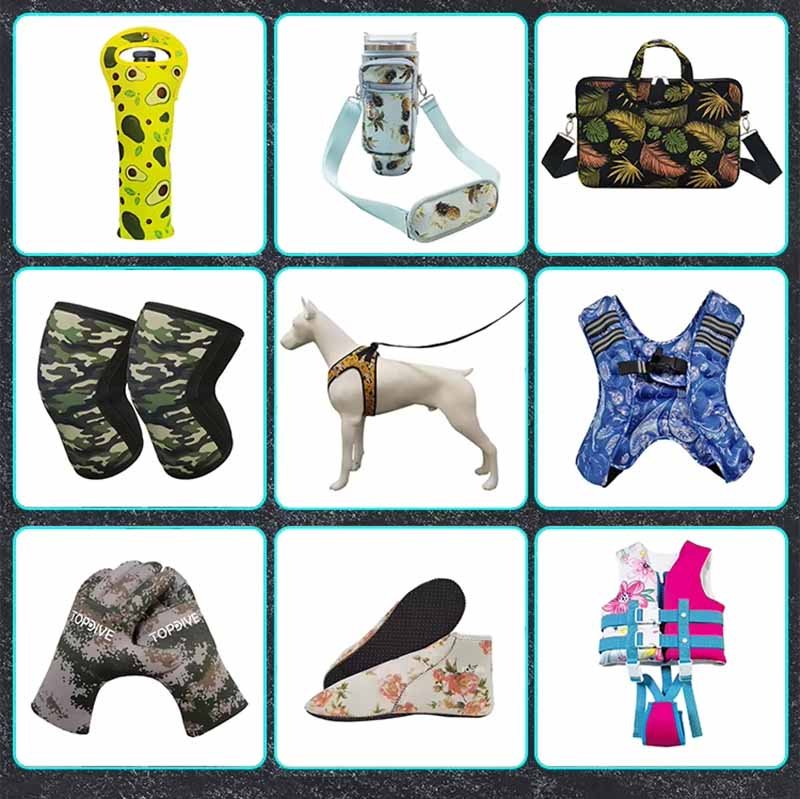
Neoprene is most effective in products that benefit from insulation, cushioning, or water resistance — such as wetsuits, gloves, koozies, laptop sleeves, and protective bags. It absorbs shock, blocks moisture, and maintains temperature stability, making it ideal for both fashion and function. Properly designed neoprene items stay comfortable and practical across sports, travel, and everyday applications.
Neoprene’s versatility stems from its three-layer performance: stretch, insulation, and impact protection.
Unlike typical textiles that specialize in only one feature, neoprene behaves like a hybrid material — both soft and structured.
1. Sports and Recreation
- Wetsuits & Surf Gear: The material’s thermal insulation and buoyancy make it unmatched for cold-water activities. A 3/2 mm neoprene wetsuit, for instance, keeps a diver’s body temperature about 2–3 °C higher than the surrounding water.
- Gym Accessories: Waist trimmers, knee sleeves, and elbow supports use neoprene’s compression to stimulate blood flow and reduce fatigue.
- Yoga & Fitness Mats: Provide non-slip grip and mild cushioning, ideal for indoor training.
2. Protective and Lifestyle Goods
- Laptop Sleeves & Tablet Covers: The foam cells act as built-in shock absorbers, resisting drops and scratches.
- Camera Bags & Gadget Cases: Moisture resistance keeps electronics safe from humidity and condensation.
- Fashion Totes & Backpacks: Modern designers use thin (2–3 mm) laminated neoprene for its structured shape and soft hand feel.
3. Insulated & Thermal Products
- Bottle Koozies & Cooler Bags: Neoprene’s thermal stability maintains drink temperature 30–50 % longer than fabric covers.
- Lunch Bags & Delivery Totes: Flexible and washable, they balance food safety with portability.
4. Industrial and Safety Gear
Neoprene’s oil-resistance and chemical durability make it useful in protective gloves and industrial covers.
It also dampens vibration in tool grips and machine pads — a less-known but valuable application.
Neoprene Across Product Categories
| Category | Typical Thickness (mm) | Key Purpose | Comfort / Heat Rating (1–5) | Comments |
|---|---|---|---|---|
| Wetsuits | 3–5 | Thermal insulation / buoyancy | ★★ Hot | Excellent for cold water use |
| Waist Belts / Supports | 3–4 | Compression & sweat control | ★★★ Warm | Great for training sessions |
| Laptop Sleeves | 2–3 | Shock absorption / cushion | ★★★★ Comfortable | Ideal for daily carry |
| Fashion Totes / Bags | 2–3 | Shape retention / soft feel | ★★★★★ Cool | Stylish & lightweight |
| Bottle Koozies | 3 | Temperature control | ★★★★ Comfortable | Retains cold better than cloth |
Observation: Neoprene’s thermal advantage becomes a design problem only when applied to full-body wear in hot weather; for accessories and structured bags, its “warmth” is a benefit, not a flaw.
The Comfort Curve
Most consumers associate neoprene with comfort through softness, not temperature. Its smooth touch and stretch rebound give it a premium feel that synthetic woven fabrics lack.
That’s why brands across the world —from sportswear to tech accessories—continue to choose it for products that touch skin, devices, or daily life.
Are There Drawbacks in Hot Weather?
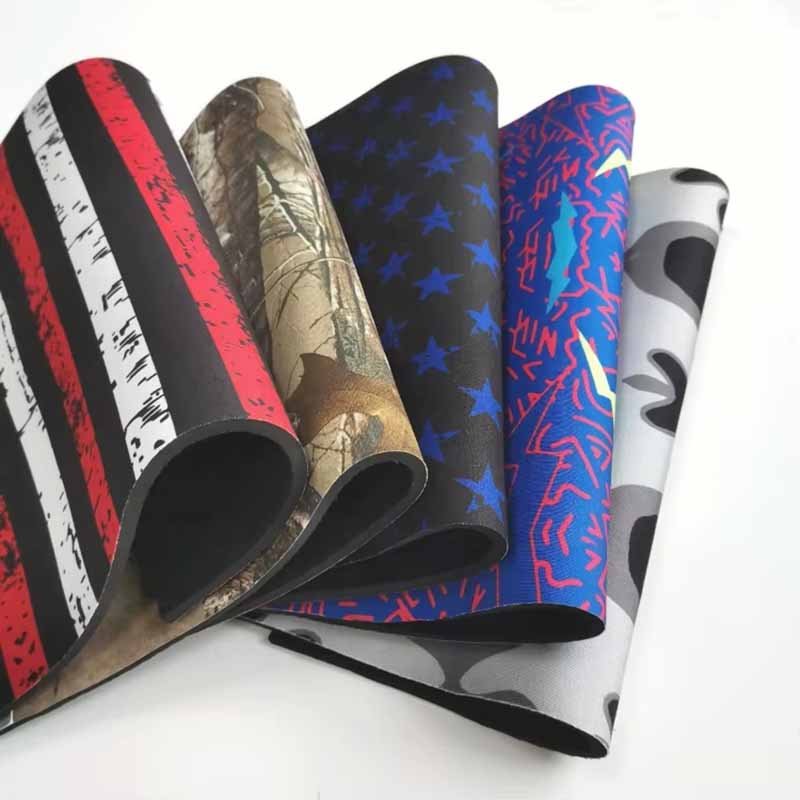
Yes. Neoprene can trap heat and moisture in warm environments because it has limited airflow and breathability. Extended wear may cause sweating or discomfort, especially in thick layers. In hot climates, choose lightweight (1–2 mm) or perforated neoprene, use lighter colors, and add fabric linings to reduce surface temperature and improve ventilation.
1. The Science of Heat Build-Up
Neoprene acts as a barrier — great for blocking cold, not for releasing heat.
Under direct sunlight, a black 4 mm neoprene surface can reach 120 °F (49 °C) within 10 minutes, compared to 90 °F for nylon.
That thermal inertia explains why users feel “sticky” after extended exposure.
2. Moisture and Sweat Retention
Because neoprene doesn’t absorb moisture, perspiration stays between skin and fabric.
This can lead to overheating or minor skin irritation during prolonged use.
Manufacturers counteract this with mesh linings, micro-vent holes, and wicking fabric bonding.
Heat Management Strategies
| Problem | Design Solution | Effectiveness (1–5) | Common Application |
|---|---|---|---|
| Excessive Heat Retention | Reduce thickness (1–2 mm) | ★★★★★ | Bags & accessories |
| Poor Ventilation | Micro-perforation / mesh panels | ★★★★ | Braces, gloves |
| Surface Temperature | Use light colors / UV-resistant coating | ★★★ | Fashion bags, auto covers |
| Moisture Buildup | Add wicking inner lining | ★★★★ | Wearables |
| User Discomfort | Hybrid blend (neoprene + nylon / spandex) | ★★★★★ | Activewear |
3. Environmental Factors
Humidity and sunlight intensify the effect.
In dry heat conditions (e.g., Arizona summer), neoprene heats quickly but cools slowly.
In humid climates (e.g., Southeast Asia), its low breathability causes stickiness.
Thus, design choices — like lighter colors and ventilation zones — are critical for comfort.
4. Usage Recommendations
- Choose lightweight neoprene for daily wear and accessories.
- Avoid dark solid neoprene for long outdoor exposure.
- Clean and air-dry products regularly to prevent odor.
- For industrial or sport applications, rotate usage to avoid prolonged heat exposure.
Temperature Comparison: Material Surface in Sunlight
| Material | Average Surface Temp after 10 min @ 86 °F Ambient | Perceived Comfort |
|---|---|---|
| Black Neoprene (4 mm) | 118–122 °F (48–50 °C) | Hot |
| Gray Neoprene (3 mm) | 108 °F (42 °C) | Warm |
| Light Beige Neoprene (2 mm) | 96 °F (35 °C) | Mild |
| Polyester Fabric | 90 °F (32 °C) | Cool |
Result: Color and thickness can lower perceived heat by as much as 25 °F (14 °C). That’s why many summer neoprene products now feature light hues and thin, perforated builds.
5. User Experience Matters
Real-world feedback shows that comfort is subjective.
- Some users find a slight warmth “comforting,” especially for joint support or bags.
- Others prefer a cooler hand feel for fashion items. Hence why modern manufacturers offer custom formulations and dual-density layers to suit specific markets.
How Do Brands and Designers Balance Warmth and Comfort?
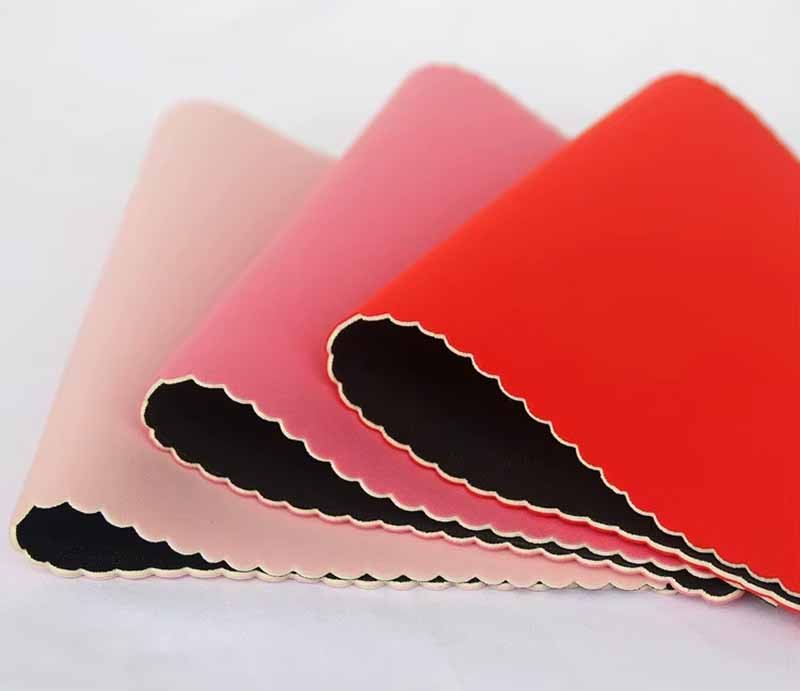
Brands balance neoprene’s warmth and comfort by using lighter thicknesses, breathable linings, perforated zones, and eco-formulations that weigh less and trap less heat. Smart pattern engineering and color selection also help maintain cooling performance without sacrificing durability or structure. The result: products that keep neoprene’s premium look and protection but feel cooler and softer for everyday use.
For decades, designers treated neoprene as a “cold-weather” fabric. Modern innovation has rewritten that rule.
The challenge today isn’t making neoprene warmer — it’s making it adaptive.
1. Balancing Insulation and Airflow
Engineers now approach neoprene like climate control: retain just enough heat for comfort, release the rest.
- Zoned Thickness Panels: Thicker over stress points, thinner on sides or underarms.
- Vent Channels: Laser-cut lines that direct airflow while preserving waterproof integrity.
- Dual-Density Foams: Soft inner core for comfort, denser exterior for structure.
Each tweak changes how long heat lingers. A 2 mm vented neoprene handbag stays 8–10 °C cooler than a traditional 4 mm solid panel version in field tests.
2. Layer Smart, Not Heavy
In accessories, designers often line neoprene with lightweight fabrics like air-mesh polyester or micro-jersey.
These linings wick sweat, reduce friction, and prevent the clammy feel users associate with “hot rubber.”
| Layer Type | Function | Heat Impact | User Benefit |
|---|---|---|---|
| Inner Wicking Mesh | Moisture transfer | ↓ Surface temp by 15 % | Feels dry longer |
| Outer Nylon Shell | Abrasion resistance | Neutral | Clean aesthetic |
| Matte Finish Coating | Sunlight diffusion | ↓ Absorption ≈ 10 °F | Cooler touch |
| Lighter Colors | Reflects IR light | ↓ Absorption ≈ 20 °F | Ideal for summer goods |
3. Eco & Limestone Neoprene Advances
Traditional neoprene comes from petrochemicals; new eco-types derived from limestone or natural rubber blends are up to 25 % lighter and more breathable.
They also produce fewer CO₂ emissions during manufacturing—something both performance brands and consumers now demand.
4. Aesthetic Meets Ergonomic Engineering
Designers merge comfort and beauty: laser-cut patterns double as style and airflow; embossed logos minimize glue layers; bright interiors signal premium craftsmanship.
The result? Products that look luxurious but function like professional gear.
Today’s neoprene bag or sleeve doesn’t scream “wetsuit”—it whispers tech elegance.
Key Design Takeaways
| Design Goal | Practical Solution | Example Product |
|---|---|---|
| Reduce heat buildup | Thinner foam + mesh lining | Summer backpacks |
| Maintain structure | Dual-layer lamination | Travel totes |
| Enhance airflow | Micro-perforation zones | Sports braces |
| Prevent sun absorption | Light matte finish colors | Beach bags |
| Eco appeal | Limestone or recycled neoprene | Sustainable brands |
Conclusion — Design Smart, Stay Cool, and Build with Confidence
Neoprene has traveled far from its scuba-diving roots. Once known mainly for warmth, it now defines a generation of protective, stylish, and technical products that bridge function and fashion.
The question “Is neoprene hot?” becomes irrelevant when the design is right — it’s as cool as the concept behind it.
Consumers no longer choose between comfort and protection. They want both — and modern neoprene delivers. With smart material choices, breathable construction, and sleek lamination, it’s possible to achieve lightweight resilience across all climates.
And that’s where experience matters most.
Partner with Szoneier — Your Trusted Neoprene Manufacturer
Behind every great neoprene product is precision engineering.
Szoneier, based in China with over 18 years of R&D and manufacturing experience, turns that precision into everyday excellence.
What Szoneier Offers
- Full OEM/ODM Services: From design concept to finished product with your brand logo.
- Customization Options: Thickness 1 – 6 mm, colors, stitching, zippers, and surface textures.
- Rapid Prototyping: Samples ready within 5 – 7 days, mass production in 20 – 25 days.
- Strict QC Systems: Compression tests, lamination checks, and color consistency audits.
- Eco-Compliant Materials: OEKO-TEX®, REACH and CPSIA certified.
- Global Delivery: FBA-ready packaging and door-to-door DDP shipping to the US, Canada, UK and EU.
From bags, koozies, gloves, covers, to wetsuits and thermal gear, Szoneier supplies both mid-size brands and premium labels worldwide with tailor-made neoprene solutions.
Ready to Create Your Next Neoprene Product?
Email: info@neoprene-bag.com
Website: www.neoprene-bag.com
Phone: (+86) 138 2313 4897
Discuss your custom neoprene project with our engineers — choose the right density, texture, and colorway for your brand.
Whether you’re developing a new eco-bag line, sports brace collection, or premium tech accessory, Szoneier brings your vision to life with professional R&D, flexible MOQ, and 100 % quality guarantee.


